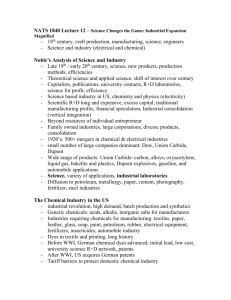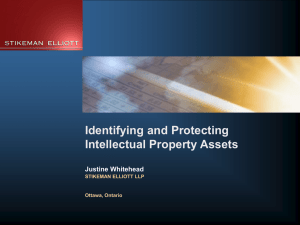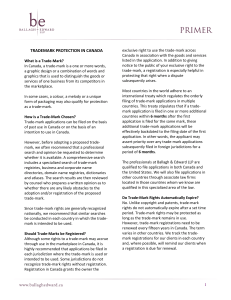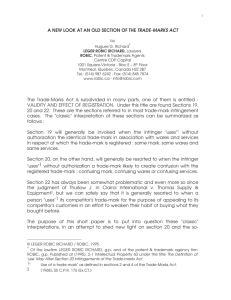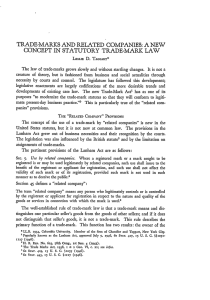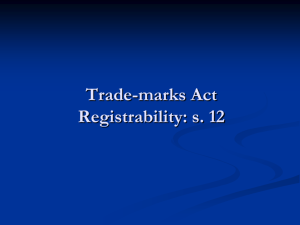The Basics Of Intellectual Property And Licensing
advertisement
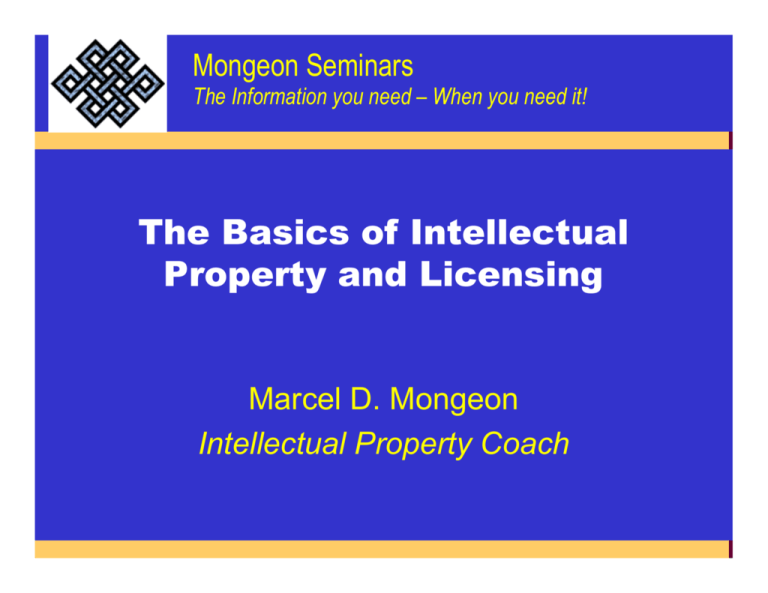
Mongeon Seminars The Information you need – When you need it! The Basics of Intellectual Property and Licensing Marcel D. Mongeon Intellectual Property Coach Outline Intellectual Property described and defined The ‘rules’: Patents Copyrights Trade-marks Trade Secrets Others The ‘End Game’ The Value of Intellectual Property RIM and NTP What’s RIM? What’s NTP? NTP is said to be a ‘patent troll’ Acquires patents solely to threaten suit and then licence Is this a legitimate use of intellectual property (IP)? The Value of Intellectual Property RIM and NTP - Effect of settlement – when was the decision? What’s in a Name? What is the value of a brand? Answer found in: Best Global Brands Report Coca Cola? Almost $67 Billion! IBM Æ $59 B Microsoft Æ $59 B How does value get created? The NIKE® story Bought design for $35 from Carolyn Davidson Now #29 (up 10% from 31) at > $12 Billion Intellectual Property What is intellectual property? Intangibles such as traditional legal regimes such as patents, copyrights etc. Also includes knowledge of employees What are Employees worth? What can you prevent an employee from doing? Can they absolutely be prevented from working for a competitor? Wal-Mart vs. Amazon amazon.com hired a number of IT execs Real ‘smoking gun’ was discovery of documents that were taken What can an organization do with Intellectual Property? Growing field as more interest in the knowledge based economy We use intellectual property in a very broad sense (i.e. know-how and other types are included even if not a ‘legal’ IP regime) McKinsey model: Use the best Divest the rest Application of Model to nonprofit Organizations Universities, Government labs and Hospital Research Does the model work in these sectors? How can they ‘use’ IP? How can they ‘divest’ IP? The field of ‘technology transfer’ AUTM FPTT The Definition of Technology Transfer What is it? Broadly stated: Anything that gets research results developed within academe into use outside of it We do this in many obvious – and some not so obvious – ways How does TT take Place? Licensing patents Creating spin-off companies Engaging in industrially-sponsored research Sometimes no agreements Research consortia Less obvious ways of TT Training students (particularly in industrial settings) Formal dissemination of results at conferences Informal discussions with industry Letting industry use research equipment and facilities IP Regimes Patents Copyright Trade-marks Trade secrets Others Plant Breeders Rights Industrial Designs Patents History: Statute of Monopolies The ‘deal’: Inventor must make a full disclosure In return they receive a monopoly for a fixed period of time Designed to encourage scientific advancement Patents – Subject Matter Definition of Invention in Patent Act (Canada): any new and useful art, process, machine, manufacture or composition of matter Specific exclusions from court decisions: Medical methods of treatment higher forms of life (Oncomouse) Scientific principles Other rules in other countries Patents – Formalities Patents require an application in each country Application in very specialized language Examination of application Term is 20 years from application Many countries require maintenance fees Patents – Requirements Subject matter Novelty Non-Obviousness Utility Patents – Costs Filing Fees are about US$500 per country Big costs are agent’s fees and translations Total worldwide lifetime cost can easily be US$500,000! Patents – Ownership Inventors start with the patent rights Who is an inventor? Policies may change this rule Public institution challenge: Have you identified all of the inventors? (Grad. Students?) Will they take action if you forgot them? Who is an Inventor? Contrast with ‘Authorship’ No definition in Patent Act of ‘Inventor’ Dependent on Facts US and Canadian case law is different In Canada: AZT: Conception with ‘sound prediction’ of success Contrast brainpower and horsepower Conclusion on patents Patents cover new and non-obvious inventions Invention is embodiment of an idea Application in each country protection is sought Expensive Copyrights History The ‘deal’ Protects an Original Expression The author should direct the use Copyright – Subject Matter Work of original expression Copyright has traditionally been able to keep up with media changes Current Challenges are the internet and multi-media In academe developing areas are: Alternative delivery methods of teaching Software and Open Source Databases Copyright – Formalities National laws protect International conventions give some automatic protection – no need for © or a notice No need to register but it gives certain presumptions Term based on life of author plus years Copyright – Ownership Owned by author unless written agreement to contrary The challenges with students, temporary staff and workers Copyright in traditional academic materials Conclusion on Copyrights Protects Expression of Idea Prior publication does not affect legal position Practical issue of discovering infringements Trade-marks The ‘deal’: Protects name that goods and services are sold with Probably the most important protection that businesses should be concerned about Internet domain names Nature of Protection Basic premise Historic basis: Anyone who sells goods as being made by someone which were sold knowing that they were not so made injured the original maker Concept of Goodwill attaching to goods Compare with services A “Common Law” trade-mark Any mark that is used to be ‘known’ by the public can be said to be ‘adopted’ in relation to the wares and services The ‘Chapters’ Bookstore case in Waterdown Protection only for trading area in which the trade-mark becomes known Registration in practice Usually at national level In US, includes states in intra-state trade Also EC moving to ‘community mark’ Nothing really similar to PCT in patents though Revisit ‘Chapters’ story To be registered Must not be ‘confusingly similar’ with mark in use Distinctive In use There is an ‘Intent to Use’ system in may jurisdictions Rights though only accrue form actual use Trade-marks and Trade names Two different forms of protection Trade-mark is the broader Trade name is the name under which business is generally done Name of corporation is a trade name not a trade mark Business style registrations are trade names and not trade marks Distinctiveness Which are strongest (not best known) trade-mark? CAMEL Cigarettes XEROX MOLSON Beer amazon.com EXXON ULTRABRITE Toothpaste CORN FLAKES Cereal What is Distinctiveness? Notion of ‘strength’ or ‘weakness’ in a mark What other meanings can this mark have? Where else might the mark be used Rationale: If we are giving exclusive rights in the mark, we need to ensure there will be little confusion in the marketplace ‘Confusing Similarity’ Usually confined to same goods or services BUT issue of well known marks Test is based on: Nature of trade Nature of the goods Would members of the purchasing public believe that they were buying the goods they wanted? How to Register a Trade-mark Each country different On-line applications In Canada In the United States Application includes Mark to be registered Identification of applicant Goods and services with which mark to be registered Actual or Intent to use indication Term of TM In Canada: 15 years Similar in US Requires some interim maintenance to increase rights Total period of time from application to registration: ~18 to 36 months Longer in Canada right now Losing trade-mark Rights Loss of distinctiveness Arborite Linoleum If mark loses distinctiveness (becomes generic) then TM can’t be enforced Enforcing distinctiveness XEROX; Rolls Royce Litigation Infringement of Trade-mark Use of confusingly similar trade-mark Usually in same goods or services as registration Some cases blatant Some cases not so obvious ‘King of Beers’ vs. Kingsbeer Most cases brought by huge TM owners Real Issues for Businesses Freedom to Operate Protecting markets Freedom to operate Requires searches Where? General internet searches a good idea Trade-mark Registers Both national and adjoining countries Company and business name registers Test on searches? Confusing similarity Question of fact not law Protecting markets Registrations are useful to protect current and anticipated (with intent to use applications) markets Which marks to protect? Word marks Design marks Logos Strategy based on resources (i.e. $$) The more resources the more applications Labeling Good labeling is part of a TM program Usual is: ® is a registered trade-mark of XYZ Inc. ® requires actual registration In some case registration not possible E.g. of Windows™ Adding distinctiveness Windows 95® Trade secrets The ‘deal’: Don’t tell; contract with others not to tell Trade secrets – Formalities Contracts: Non-disclosure agreements Confidentiality agreements Subject matter: Just about anything Examples Coca-Cola recipe New computer algorithms Practical Problems with Trade Secrets How to let others know the secret? Is Coca Cola kosher? When the Genie gets out of the bottle? Trade secrets and Public Institutions Conflict between our traditional mission of free dissemination of information and industrial needs Can we live up to our obligations? Should research institution sign a nondisclosure agreement? What extra steps are you ready to take to safeguard information? Other Regimes Plant Breeders Rights Rights relating to traditional breeding techniques Industrial Designs Ornamentation without functional purpose Cf. with US Design Patent Protected IP – What is it worth? Patents, TMs, Copyrights etc. cost money to register and police Just because you have a patent does not mean the world will beat a path to your door! Valuation depends on markets What can you do with IP? Back to McKinsey: Use the Best; Divest the Rest We’ll look at sources of IP And divesting of IP Sources of IP What is the culture of the organization? IBM pre-PC The development of the PC Sometimes IP isn't recognized in a company? Value is lost What do these items have in common? History of Xerox PARC Established in 1970 by Xerox in Palo Alto, CA Created most of the innovations behind the computer age: Laser printer Graphical User Interface Mouse Ethernet, etc. etc. Xerox never commercialized anything Why not? Uses of IP Back to Tech Transfer: Licensing patents Creating spin-off companies Engaging in industrially-sponsored research Research consortia Licences An owner can give rights to anyone else Challenge is defining the scope Examples: Exclusive or non-exclusive Geography Field of use The big issue: Royalty – How much? Start-up Companies Use IP to base a new company Why cut the apron strings? In not-for-profit may be needed to get on a for profit footing Benefits Tax holidays; SR&ED credits; “Free” money Real challenges: People/People/People! Industrially-Sponsored Research Benefits of matching money Access to equipment and expertise Possible future hires A look into the future Research consortia: Can you really work with your competitors? Its us against the world; Trend spotting Eg. Ontario examples of photonics expertise Reality of Intellectual Property 100.00 90.00 80.00 70.00 60.00 50.00 40.00 30.00 20.00 10.00 0.00 -10.00 McMaster University FY97 to FY06, Net Revenues/Disclosure over Disclosures, Max revenue=100 Career Opportunities In the patent field As patent agent trainees As patent examiners www.cipo.ic.gc.ca Looking for: Biotechnology; Electrical; Organic Chemistry; general Chem; Mechanical Technology Transfer field Industry with an IP background Business Development Conclusion Value of IP The rules for: Patents Copyrights Trade-marks, etc Acquiring and divesting IP “Gotta kiss a lot of frogs to find a prince!” Questions? Marcel D. Mongeon +1 (905) 481 0133 marcel@mongeonconsulting.com




